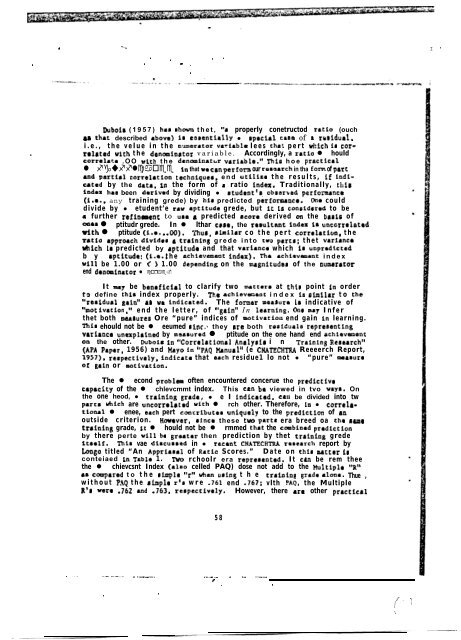Technical Report - International Military Testing Association
Technical Report - International Military Testing Association
Technical Report - International Military Testing Association
Create successful ePaper yourself
Turn your PDF publications into a flip-book with our unique Google optimized e-Paper software.
.<br />
-._<br />
. .<br />
. .<br />
- .<br />
.<br />
. *<br />
Duboie (1957) hor rlhovn thet, ‘*e properly conetructod retie (ouch<br />
u that described ebove) te eaecntlelly � opeciel cane of a reelduel,<br />
i.e., the velue in the rmrnoretor vorfeble lees thet pert wkfch fe cortolated<br />
vich the denanioator variable. Accordingly, a rotio � hould<br />
corralaza .OO with the dcnaminattir verieble.” Thin hoe practieel<br />
� ����������� fa that ue ten perfom our rcteaerch in tha form of port<br />
and pariiel corraletion technlquae, end utiilee the results, if lndlutad<br />
by the dete, la the form of a ratio Index. Traditionally, thfo<br />
index has been derived by dividing � atudent’e, obearked performance<br />
(i .a., any training grede) by hie predicted parformeaco. One could<br />
divide by � etudent’e rw eptftude grede, but it ie coaoiderad to be<br />
8 further reflnmeeat to luee e predicted score derived on the beeie of<br />
OQ@O � ptitudr grede. In � lthar ceee. the reeultent index 18 untorrelated<br />
tith � ptitude (i..., .OO). Thur. rlmller co the pert correletlcm, the<br />
retfo epproech dlvidec m trelning grede into tm pertr; thet verfrnce<br />
rrhich fe predicted by rpritude and that verience which is unpredkted<br />
b y aptitude: (i.e.,the achlavemeut index). 7714 ochiavemaant index<br />
will be 1.00 or < ) 1.00 dcpandfng on the megnltudee of the cmmrator<br />
end denmfnator � ������<br />
It me7 be benoflcfrl to clarify two uuttere at thie point in order<br />
ta define thlr index properly. Tha achisvaneat index 1s oiraller to the<br />
“reelduel goin” AS we Fndfcetsd. The former meeure ie indicative of<br />
"mot ivat ion ,I’ end the letter, of “gain” In leeruing. One rae7 Infer<br />
thet both maneuree Ore “pure” indices of motivotiou end gain in learning.<br />
his ehould not be � eeumed *inc.> they era both roeiduole repreeenting<br />
verieace unexplelned by mserured � ptitude on the one hand end athlsvement<br />
on the other. Dubole In “Correletlonel Analyrie i n Training Reeeerch”<br />
(APA Peper, 1956) and Hayo in “PAQ Kenual” (e CNAl7XHlXA Reeeerch <strong>Report</strong>,<br />
1957). rtepactlvaly, indfcete that each residue1 lo not � “pure” meeeura<br />
of Rein or motlvetloa.<br />
The � econd problem often encountered concerue the predlctLve<br />
cepeclty of the � chlevcmmt index. This cm ba viewed in tvo ueye. On<br />
the one heod, � trefnlag ;grede , � e I indiceted, emi be divided into tw<br />
pert8 which are uncorraletad vith � rch other. Therefore, in � correletlonel<br />
� enee, eech pert connrrlbutee uniquely to the prodlctlon of an<br />
outside criterion. Houevcsr, rfnce these two pert8 era breed oa tha aeae<br />
trrlning grade, tt � hould not be � rmmed thet the cwbiood prrdlction<br />
by there perte will be grtrrter then prediction by thet trelnLag grede<br />
iteelf. This vae diecurecd in � reeanS f3UTECHTR.A rorcerch report by<br />
-go titled “An ApprLerell of Retie Scores.” Date on thlr mtter ir<br />
conteiaed In Tcible 1. TV0 rchoolr era reprsrrnted. It ten be rem thee<br />
the � chievcsnt Index (elno celled PAQ) dose not add to the Multiple ‘1”<br />
AS coutpered to the rfmple “r” vtmn uring t h e training grade clone. Thue ,<br />
without PAQ the OLmple r’(i wre .761 end .767; vlth PAQ, the Multiple<br />
B’S vere .762 end .763, rcepcctfvely. However, there ere other prectieel<br />
_ ,.. -- ---- . . .-__ ^_. ._..- __ - -- .._-<br />
I<br />
.<br />
.<br />
.<br />
58<br />
.<br />
i<br />
‘.<br />
/- ;<br />
I *









